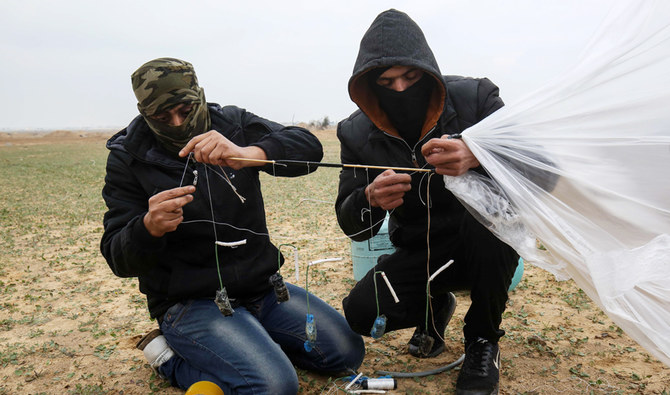
- ARAB NEWS
- 19 Apr 2024

Hazem Balousha
GAZA CITY: The launch of incendiary balloons from the Gaza Strip into Israeli territory could mark the resumption of hostilities after some Palestinians expressed frustration at the lack of results from the temporary agreement with Israel.
There was no official announcement from the Palestinian factions about renewed hostilities, and Talal Abu Zarifa, a member of the Committee for the Return March, described them as “individual actions.”
Egypt had brokered a short-term agreement between Hamas and Israel in October 2018 to ease Israel’s blockade of the Gaza Strip and provide concessions in exchange for easing demonstrations on the border.
These included increasing the fishing zone in the Gaza Sea, allowing an increase in exports of products from the Gaza Strip, and the import of some materials that Israel had banned.
Media reports spoke of additional talks recently in Cairo to reach a long-term agreement between Hamas and Israel, which had been unsuccessful.
Bassem Naim, a Hamas leader, said the discussions were about extending the duration of the arrangement for an additional six months, as the previous timetable ended in December.
“The talk about a long-term agreement is only media gossip. The talks were centered on extending the duration of the previous understandings. There is no progress in the Israeli implementation of what has been agreed upon so far,” Naim said.
He added “Israel always make elections as excuse to prolong the period of understandings without improving them.”
The October 2018 agreement talked of two phases. The first was to provide specific facilities for the Gaza Strip, and the second was to begin after the formation of the Israeli government over a long-term truce that would include a prisoner exchange deal.
Political science professor Mokhamar Abu Saada believes that the tension on the Gaza border is over the slow implementation of the agreement.
“We have noticed in the previous Israeli election period that there was an escalation as Hamas and factions tried to obtain more Israeli facilities. It was a way to pressure the Israeli government as it knew that the Israeli reaction would be limited in this period,” Abu Saada told Arab News.
“Netanyahu cannot at this stage reach a long-term agreement with Hamas because of the Israeli elections, because all he wants is to keep the Gaza Strip calm without tension, but he has no ability to offer much,” he added.
Press reports talk of a tension between Hamas and Egypt that led to the recent escalation in the Gaza Strip. Taher Al-Nounou, media adviser to Ismail Haniyeh, denied this.
He said in a press statement: “The head of Hamas attaches special importance to this firm and growing relationship (with Egypt), as Egypt has from its geographical position a central role in the path of the Palestinian issue.”
Egypt allowed Haniyeh to travel on a foreign tour at the end of last year for the first time since he became head of Hamas in 2017.
A Hamas leader who declined to be identified said that there is a tension in the relationship between Egypt and Hamas as a result of Haniyeh’s visit to Tehran to participate in the funeral of Qassem Soleimani.
“Hamas promised Egypt that Haniyeh would not visit Tehran but after the assassination of Soleimani there was a necessity to do so, which angered Egypt and increased tension,” he said.
Haniyeh’s presence at the funeral sparked a debate in Palestinian circles about Hamas’s position on Iran, and on Soleimani specifically.